
I remember when my family and I used to binge-watch Gordon Ramsay’s Kitchen Nightmares, a show where world-renowned chef Gordon Ramsay would travel to struggling restaurants, define the problems they are facing, and work with the restaurants to fix them. Of course, every episode and restaurant had a unique set of issues, whether it be subpar food, mediocre service, inefficient systems, uncleanliness, or any combination of them.
But what these restaurants had in common was that virtually all of these external problems could be traced back to bad leadership. And that bad leadership is the result of one crucial internal problem: a lack of empathy.
In many of these episodes, the restaurant owners become too confined in their ego to accept the problems within their restaurant and to embrace necessary changes in the way they run the system in order to regain customers. For example, they could deny the problems with the efficiency of their kitchen, the cleanliness, or the poor quality of their food—even when the customers express dissatisfaction to their face.
People who cannot temporarily let go of their role or status or set aside their own expertise or opinion will fail to empathize with others who have conflicting thoughts, experiences, or mental models.
Katja Battarbee, Jane Fulton Suri, and Suzanne Gibbs Howard
This quote from the article for IDEO “Empathy on the Edge” sums up the root of virtually all the situations in the show. In a nutshell, most of these restaurants were failing because the owners were unwilling to understand the feelings and needs of their customer base and staff. Additionally, some of the owners either ended up being too stubborn to accept changes, or they temporarily accepted them only to relapse into their old ways, eventually leading to the closure of the establishments.
So by now, you probably get the point: empathizing with your constituents is important for your product or service to succeed. But for more complex products and services—outside the realm of good food and restaurant atmosphere—empathy, and knowing how to get there, can get trickier.
That being said, there is a plethora of empathic research methods that have been proven to help representatives of products or services overcome their biases and better understand the perspectives of their customers and stakeholders. I will discuss three common research methods here.
1) Service Safari (Actually Being the Customer)

This does not mean merely thinking about what a customer might go through; it’s about actually going through the journey first-hand—walking in the customer’s shoes. Here, the representative “takes on the persona of a user/customer” and attempts to complete a task within the scope of the exercise. Simply put, the representative is the customer.
Going back to Kitchen Nightmares, Gordon Ramsay incorporates this method by posing as a regular customer and going through the journey of entering the restaurant under first impression, being waited on, and eating the food.
Ramsay takes it a step further in his sequel 24 Hours to Hell and Back and actually puts on a disguise so that the restaurant caters to him without bias (knowing he’s a celebrity chef). After service, he reveals himself and exposes to the restaurant representatives how (awful) his experience was.
This method can be effective at highlighting blatant problems as well as identifying more subtle opportunities for improvement. You don’t need a world-renowned chef to do this, though, so long as you put aside your own perspectives and have someone (such as yourself) who is willing to go in with an open mind.
2) Interviewing via the Five Why’s

Interviewing may seem obvious, but knowing what questions to deliver and how to deliver them are essential for receiving accurate information from the customer. One approach to interviewing that is surprisingly effective is using the Five Why’s.
When I first heard this method, I thought of when nosy toddlers and elementary school children would continually repeat “why?” to someone whenever they didn’t understand something or didn’t get their way. The other person would be required to dig deeper in their responses until they get too annoyed by the toddler’s nosiness.
However, the interview process doesn’t have to be this annoying and intrusive (and shouldn’t be) for the interviewee. With this method, you should be reframing many of your why’s in ways that engage with each response in order to find a deeper understanding of what a customer is experiencing or had experienced.
The key is to start with asking about a broad problem and then narrowing it down, like in this example.
- Why is the website slow?
- The plugins haven’t been updated and there are a ton of back-end bugs.
- Why do you think is that?
- Well I’m not sure, but we have had trouble getting a hold of our web developer firm.
- Why?
- The firm is located two timezones away and they have a lot of other clients, so we’re basically on a waiting list.
- Why did you choose this firm if this would be the case?
- We thought they would be a good fit for our business.
- Why would they be a good fit?
- Their website themes looked great and they had good reviews.
You would not know any of the details and stories as to why the website was slow had you only stopped at the first why. Apply this to any customer experience and you will get to know the customer’s deeper feelings and circumstances, without sounding too intrusive, when they may not admit them initially.
3) Storyboarding (When You’re on a Budget)

I view this method as a watered-down, cost-effective version of the other two methods. Yes, you aren’t actually in contact with an actual customer. However, this method is great for visual learners. It can get your teammates to be in the loop on your ways of thinking, and it doesn’t necessarily require you to leave your workspace.
You can also get creative with this. You can use many physical objects to represent scenarios, such as photography, hand sketches, post-it notes, and figurines. For example, you could create multiple scenarios of different kinds of customers—small children, adolescents, adults, and elderly with fragile hands—attempting to open up your package design. You may use differently sized figurines to represent each group, or use stock photos or sketches.
Your teammates should have the opportunity to add their own input and perspectives as well. Also, while this method may act alone, it may actually be more effective to use it to brainstorm other methods such as the Service Safari.
Conclusion
We all have biases and believe to a certain extent that our view of the world is everyone else’s view. It’s much easier to assume this too, which is why we tend to surround ourselves with like-minded people. But, there comes countless times when reality slaps us in the face and we just have to admit that we were wrong about an important subject. Through these research methods—and many out there like such—we may start to gain true empathy for our constituents and finally “stop being in denial,” as Gordon Ramsay would say.







ينعكس التزام المصنع بالابتكار في جهود البحث والتطوير المستمرة لتحسين تصميم ووظائف تركيبات HDPE و uPVC الخاصة بهم. إيليت بايب Elite Pipe